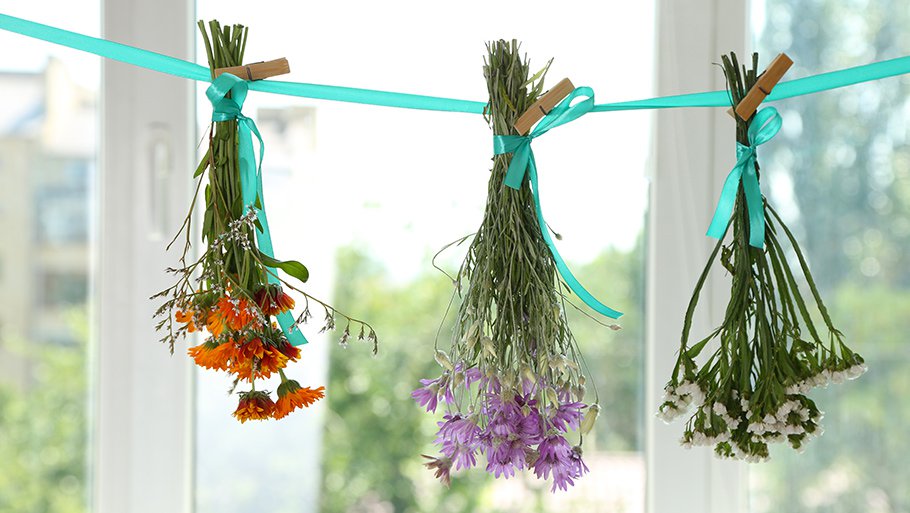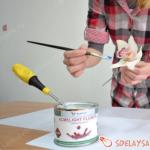How to properly dry flowers at home
Dried flowers are a wonderful home decoration. With their help, you can create exquisite compositions, make the room more comfortable and colorful. In order for such a bouquet to retain its original appearance and brightness for a long time, not to break or crumble, it must be properly dried. How to dry flowers at home? Let's figure it out.

Collection rules
- For a colorful and long-lasting dry composition, pick the flowers in the afternoon, when the dew has completely disappeared. Using a garden shears, carefully cut the stem 2–3 cm from the ground.
- For drying, buds that have just begun to bloom are suitable. Usually, when the flower dries, it opens even more, and if you choose a completely blossoming specimen for the herbarium, then it is highly likely that during drying most of the petals will fall off it. Keep in mind that wilted and spoiled plants are not suitable for herbarium. After drying, they will look lifeless and sloppy.
- Harvest the plants to dry in the afternoon, when the dew is completely gone.
Training
- Arrange the collected flowers on the table and remove excess leaves and thorns.
- Group the plants by type and arrange them 10 in one bunch. Dry large flowers (peonies, roses, hydrangeas) one by one.
- Insert a special flower wire into the thin stems of plants such as immortelle, bellflower, aster. This will help protect the dried composition from breakage.
- Tie the arranged bouquets with a rubber band at the base of the stems. Do not tighten the elastic too tight. If the tape digs hard into the stem, liquid will accumulate in it, and the plant may rot. Some needlewomen use twine or taffeta instead of elastic. In this case, as the stem dries up, you will have to update the harness and make it tighter.
After the preparation is over, you can start drying.
Drying naturally
Drying flowers in the air is the simplest and most affordable option among the existing ones. All you need is to hang the prepared bouquets on hooks, hangers or nails in a dry, dark place with good ventilation.
The optimum drying temperature ranges from +10 to +18 ° C. To prevent the flowers from rotting, try to place them freely from each other and 15–20 cm below the ceiling. Depending on the size of the bud, drying can take 1–3 weeks.
Keep in mind that the stems of the flowers will fully straighten out as they dry. For a more natural look, dip in water for a short time. After the stalk is soaked, experiment with its shape, press down with something heavy and dry again. Fix the finished decor with hairspray.
In bulk solids
For maximum preservation of the appearance of valuable flowers, use dry in bulk substances. For example, perlite, silica gel or borax. These products absorb moisture very well, so the plants dried in them retain the appearance and brightness of colors.
- Separate the bud from the flower and insert the wire into it, twisting the rest of it into a ring under the head.
- Pour the required amount of dehydrant into a deep container. If you do not have the tools listed above at hand, use cat litter, which contains silica gel, prepare a mixture of flour and borax (1: 1), or fire river sand on the stove. The layer thickness should be at least 3-4 cm.
- Place the flower stem side down in the desiccant. If you want to place several plants in the container, then make sure that there is a distance of at least 2 cm between them.
- Sprinkle the substance over the flower heads carefully. Try to get it as deep as possible inside the flower. Correct bent petals with a toothpick.
- After the bud is completely submerged in the desiccant, close the container tightly with a lid and store in a cool place for 4-6 days. When using river sand, the drying time will be 2-3 weeks.
- After drying, gently remove the flower with tweezers and shake off the remaining powder. If necessary, use a rubber bulb and blow gently on the petals. Pour the rest of the product back into the container and use for the next drying.
In glycerin
The liquid method of drying is suitable for preserving the leaves and branches of shrubs.
- Tear off the lower leaves or branches from the plant (barberry, cotoneaster, fern, amaranth and others) and slightly split the stem from below.
- Place it in a container of water and leave for 3-4 hours.
- Prepare a solution of hot water and glycerin (2: 1).
- Drain the water from the vase and replace it with the prepared mixture.
- Make sure that the layer thickness is at least 10-15 cm.
- Remove the future herbarium in a dark, cool place and leave it there for 15–20 days.
With an iron
This drying option is best used for leaves and small flat flower buds such as pansies, primrose, or clematis.
- Place the flower on paper napkins, thin cardboard, or tissue paper.
- Smooth out the petals gently, cover with more paper and iron.
- Replace the paper sheets with new ones and continue with the evaporation procedure.
Using the press
Place the plants under the press that you plan to use in the panel in the future.
- Wrap each flower with paper napkins and spread them over the plywood lined with newspaper.
- Cover the top with thick cardboard or another sheet of plywood and press down with a load.
This option is good because several layers of plants can be dried under one pressure. To speed up the process, change the damp paper and rearrange the flowers once a day. After 5-7 days, dry blanks can be used in further work.
In a convection oven
If you need to dry flowers for herbarium or composition as quickly as possible, use a convection oven.
- Prepare a small piece of fine wire mesh.
- Place it on a wire rack and punch holes in it.
- Carefully thread the stems through them so that the flower is in an upright position.
- Preheat the oven to +38 ... +40 ° С and place the grate with flowers in it. Do not use a conventional oven to dry flowers.
- After 7-8 hours, remove the dried plants from the cabinet and cool at room temperature.
Features of drying some types of flowers
- For plants such as heather, lavender, goldenrod, periwinkle, echinopsis, gypsophila, use a natural drying method.
- Before drying, hold the roses over boiling water for 15–20 seconds.
- Dry hydrangeas, ball artichoke, lavender, yarrow, heather and cloves in two steps. First, keep them for several days in a vase filled with 3–5 cm of water. After the plants wither a little, transfer them to a flat horizontal surface and dry them lying down.
- You can speed up the drying of the spool, hisophila and cuff using a microwave. Put them in the oven and hold for 2-3 minutes at medium power. Then remove and air dry.
- Delicate and fragile flowers, such as violet, bell, orchid, dahlia, magnolia, water lily, should preferably be dried in free-flowing powders.
Now you know how to dry flowers at home. Remember: it takes not only patience, accuracy and time to dry the buds properly, but also the desire to embody your creative ideas.
4.5555555555556
4.56 out of 5 (9 Votes)



